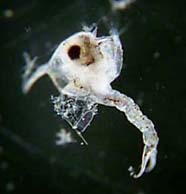| |
Glossary of Coral Reef Terminology - Z
zeitgeber - a periodic environmental signal that entrains a biological rhythm. For example, a cycle for a circadian rhythm, but may also be a temperature or even social cycle |
zenith - the point of the celestial sphere which is directly overhead |
zip - a compressed file format (.zip); to compress a file using a zip utility. Compression is generally used to speed up the transport of large or multiple files. After the file has been downloaded, a decompression application is needed to "unzip" it |
zoanthella - an elongate larval form of Zoanthidea with a ventral band of very long cilia |
zoanthid - an anemone of the family Zoanthidae, usually found in intertidal areas and coral reefs . In some species the polyps separate from each other almost completely after budding, while in other species, the polyps are all interconnected by a common mat of tissue |
zoanthina - an oval larval form of Zoanthidea with a girdle of long cilia near the oral pole |
zoarium - the form of a bryozoan colony |

A zoea larva. (Photo: Marine Ecology Laboratory, Shimoda Marine Research Center, University of Tsukuba)
|
zoea - a free-swimming larval stage of various crustaceans |
zonate - divided by parallel planes, e.g., zonate tetraspores, found in certain species of red algae |
zonation - the occurrence of single species or groups of species in recognizable bands that might delineate a range of water depth or a range of height in the intertidal zone |
zone - a large-scale physical feature within the ecosystem. Reef zones are determined by currents, wave surge, exposure to sunlight and water depth, and may be comprised of a number of habitats |
zoning - a process in which a marine protected area is divided into discrete zones and particular human uses of each zone are permitted, often with conditions such as gear limitations in fishing and waste discharge prohibitions in tourism. In the U.S., marine sanctuaries, national parks, national wildlife refuges, and state MPAs are some examples of areas that may be zoned |
zoochory - the dispersal of plant seeds or spores by animals. Endozoochory is zoochory within the animal's body. Exozoochory is zoochory where the seeds are attached to the outside of the animal's body |
zooecium - the skeleton of a bryozoan zooid |
zoogenic - pertaining to changes caused by animals or their activities |
zooid - of the distinct individuals forming a colonial invertebrate animal, such as a hydrozoan |
zooidal - pertaining to a zooid, as for example, a zooidal form |
zoology - the scientific study of animal life. Zoological sciences include the studies of evolution, systematics, cell biology, biochemistry, micro and macro anatomy, development, genetics, physiology, ecology, biogeography, biodiversity, behavior and sociobiology |
zoonose - a disease of non-human animals that may be transmitted to humans, or may be transmitted from humans to non-human animals |
zoophyte - an invertebrate which resembles a plant in appearance or mode of growth, as for example, hard corals, sea fans, and other soft corals, sea anemones, hydroids, bryozoans, sponges, etc., especially any of those that form compound colonies having a tree-like form |
zooplankton - animal component of the plankton community |
zoosemiotics - the study or analysis of animal communication |
zoospore - a motile, flagellated spore |
zootoxin - any poisonous or venemous substance produced by an animal |

Zooxanthellae. (Photo: Scott Santos)
|
zooxanthellae - a group of dinoflagellates living endosymbiotically in association with one of a variety of invertebrate groups (e.g., corals). In corals, they provide carbohydrates through photosynthesis, which are used as one source of energy for the coral polyps. They also provide coloration for the corals |
zooxanthellate coral - a coral that has zooxanthellae in its tissues |
Zulu time (Z) - one of several names for the 24-hour time period. Other names for this time measurement are Universal Time Coordinate (UTC) or Greenwich Mean Time (GMT) |
zygocardiac ossicles - triangular plates, usually bearing denticles, which project into the cavity of the cardiac stomach in decapod crustaceans, such as shrimps,crabs and lobsters; part of the gastric mill |
zygote - a fertilized egg with the diploid number of chromosomes formed by the union of the nuclei of male and female gametes |
zymogen - an inactive enzyme precursor that requires a biochemical change, such as a hydrolysis reaction revealing the active site, for it to become an active enzyme |
|
|
|
|

